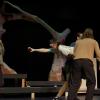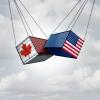Hundreds of people attended a special ceremony on October 12, 2016, to honour the raising of a third totem pole at Shq’apthut, VIU’s Aboriginal Gathering Place. The three totems at Shq’apthut represent the three major language groups on Vancouver Island and the Sunshine Coast – the Kwakwaka’wakw, the Coast Salish and the Nuu-chah-nulth. The totems demonstrate the University’s commitment to supporting Indigenous education and to creating an open, welcoming and culturally relevant campus for all First Nations students and community partners.
November 15, 2016 - 1:00pm
Hundreds came out to a special ceremony honouring the third pole, which represents the Kwakwaka’wakw Territories
NANAIMO, BC: Three majestic totem poles representing the three major language groups on Vancouver Island and the Sunshine Coast now stand tall at Shq’apthut, Vancouver Island University’s (VIU’s) Aboriginal Gathering Place.
The third pole, representing the Kwakwaka’wakw Territories, and carved by artist Tommy Hunt Jr., joined the other two poles at Shq’apthut on October 3, 2016. Hundreds of people, including representatives from the 13 nations in the Kwakwaka’wakw Territories on East Vancouver Island as well as other First Nations communities; VIU Elders, students, staff and faculty; local, municipal and federal politicians; school groups; donors; and community members attended a special ceremony on October 12 to honour the raising of the latest pole. The event included a ceremony at Shq’apthut, followed by lunch and cultural dancing and singing in the gym.
“This final pole at Shq’apthut is just one more way that First Nations communities can see themselves at Vancouver Island University,” said Dr. Ralph Nilson, VIU President and Vice-Chancellor. “This pole coming to life on our campus is another opportunity for us to educate ourselves, our students and our communities about reconciliation and what it means for each of us to accept the responsibility of reconciliation in Canada. Through projects like these we strengthen the partnerships that help us move forward with education as a fundamental tool for building mutual respect among all Canadians and emancipation for all.”
The Totem Pole Project began in 2014 when the VIU Students’ Union had a vision of Indigenizing the space outside the building with three totem poles – each carved by artists from the three major language groups in the regions VIU serves on Vancouver Island and the Sunshine Coast: the Kwakwaka’wakw, the Coast Salish and the Nuu-chah-nulth. Their goal was to demonstrate the University’s commitment to supporting Indigenous education and to create an open, welcoming and culturally relevant campus for all First Nations students and community partners.
The first two poles, carved by artists Noel Brown from the Coast Salish Territories and Qwaya Sam from Nuu-chah-nulth, were celebrated at a community gathering in June 2015. The three totems at Shq’apthut join the totem in the Library carved by Snuneymuxw First Nation master carver James Johnny and his son, James Johnny Jr.
The project also included a partnership with industry – the Western red cedar trees used to carve the poles were donated by Island Timberlands, Western Forest Products and TimberWest. Representatives from those companies attended and spoke at both celebration ceremonies.
The ceremony honouring the third pole and artist Hunt Jr. was co-hosted by VIU and the VIU Students’ Union. It began with a welcome from VIU Elder-in-Residence Gary Manson, who also called upon witnesses from different communities to observe what was said and done that day and to pass on the knowledge to future generations.
Sherry McCarthy, who spearheaded the project when she was Chair of the VIUSU in 2014, was overcome with emotion when she got up to speak.
“I appreciate the fact that we had so many people come and support this project, including the donors, allowing us to do some things that weren’t done before,” she said. “We know this work needs to be done, and I hope others follow in the footsteps of VIU.”
After the speeches, Hunt; Adam Dick, Hereditary Chief of Tsawataineuk First Nation; and Kim Recalma, Dick’s partner; blessed the pole with eagle down while singers from the Kwakwaka’wakw Nation sang traditional songs. Dick, who is Hunt’s Uncle, and Fred Speck, a VIU student and relative of Hunt, spoke on behalf of the carver, and bestowed a Kwakwaka’wakw name on Nilson – Kwa’kwa’ni – which means crane. A mourning song was also sung for Hunt’s Uncle, Mark Hendersen, another well-regarded artist, who passed away the morning of the celebration.
“This pole represents all of the Kwakwaka’wakw People,” said Speck. “Personally, I want to say thank you to Waɫawidi [Hunt’s traditional name], as a Kwakwaka’wakw myself, for what great work you’ve done here. Waɫawidi has told a great story to the people, to the thousands who will come through this hallway to see who we are.”
Hunt’s pole representing the Kwakwaka’wakw Territories includes a raven, a wolf, a bear, a frog, a Kingfisher, a sea monster, two coppers (a sign of wealth) – one with a kolus (juvenile thunderbird) on it and the other with a whale on it, and a sun in memory of his granddaughter, who passed away earlier this year.
Dr. Sharon Hobenshield, VIU’s Director of Aboriginal Education and Engagement and emcee of the part of the celebration hosted at Shq’apthut, thanked Hunt for the beautiful legacy. She called the totems a beautiful, visual representation of these First Nations.
“They speak to the First Peoples of Vancouver Island, acknowledging their history and ancestors, and they’ll be here for future generations of students who come to VIU, to demonstrate VIU’s commitment to recognizing these Nations and to build relationships with these three nations,” she said. “Everyone is struggling with the big ‘R’ in reconciliation, but it is really the small ‘r’s that are important – how we see each other and create relationships in our everyday existence.”
The Totem Raising Celebration is part of Reconciliation Road, a series of events and activities VIU is hosting this year to engage people in the reconciliation process. Visit viu.ca/reconciliationroad to learn more or click here to watch a video of the event.
-30-
MEDIA CONTACT:
Jenn McGarrigle, Communications Officer, Vancouver Island University
P: 250.740.6288 | C: 250.619.6860 | E: jenn.mcgarrigle@viu.ca | T: @VIUNews
Tags: In the Community






